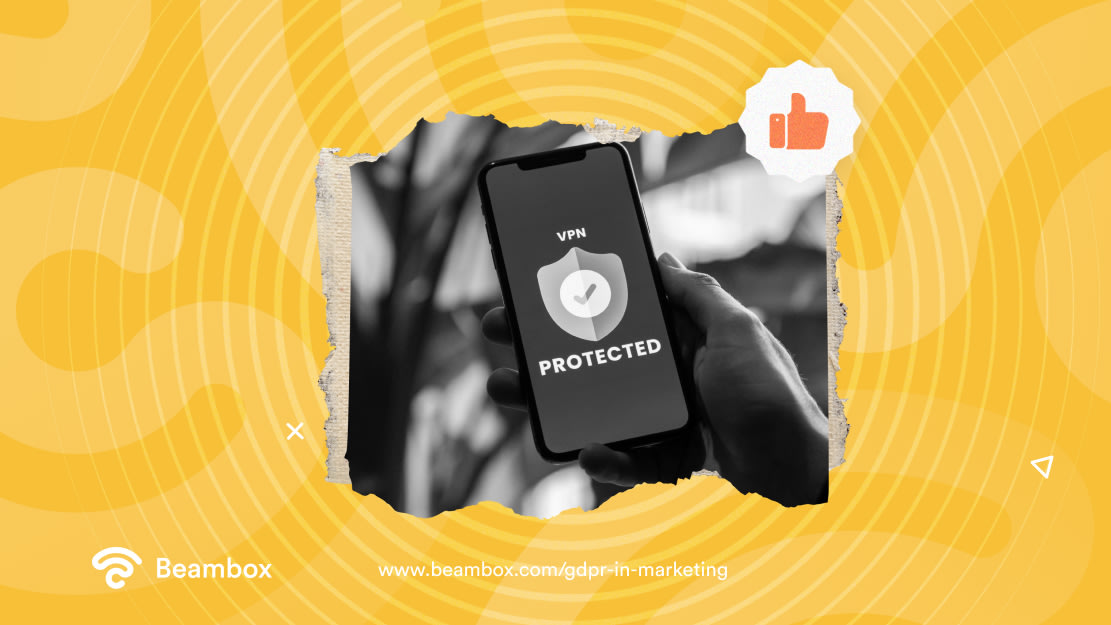GDPR in Marketing: Sweating the Small Stuff
Do you live in the European Union? Or does your business operate there? If you answered yes to either question, you’re going to need to understand General Data Protection Regulation in marketing. This data governance law has a strict list of obligations you must follow when operating in its territory.
This stuff comes with the territory; you’ve got to ensure that every aspect of your operations is compliant. Nobody wants hassle like DMCA complaints or legal action over data protection failures.
It’s the perfect example of why you should actually sweat the small stuff. Disclaimer: Small stuff can often be a huge deal, and nobody wants that blowing up in their face.
It can be overwhelming, but don’t worry; we’re here to help you understand all these requirements.
In this guide, we’ve got definitions coming up (so you can understand exactly what GDPR entails). We’ll also cover how it affects various strategies, like email versus digital marketing.
Give us ten minutes, and you’ll leave as an absolute GDPR pro!

What Is GDPR in Marketing?
GDPR is a data governance law that specifically applies to companies operating within the European Union. This includes any businesses that have relations to any of the regions whatsoever, like shipping products to European countries. If you have contact with an EU citizen or address, you need to be GDPR-compliant
Some protective laws were already in place, but European governance launched this new framework in 2018. In essence, GDPR in marketing just means that you have to obtain customers’ permission when using their data. It primarily impacts website and Google marketing strategies but also approaches like email marketing. Personal information cannot be snatched secretly for marketing gains.
If you run a website collecting things like cookies, you’ll have to set up a pop-up. This way, visitors can opt in or out with full consent and knowledge of what’s being collected. A cookie agreement and privacy policy pop-up are an absolute must. You should also ensure there’s a visible privacy policy page should visitors want further information.
Regardless of whether you’re organizing email marketing for banks or a simple website selling keyrings, GDPR matters. It limits the interactions you can have with EU customers. Essentially, it gives them more control over dipping out earlier in the lead process.
Here are just a few of the checklist obligations you have to tick off before becoming officially compliant:
- Complete a mandatory information audit if your company has over 250 employees.
- Name a fair legal justification for why you need to collect data.
- Write a Privacy Policy that’s easily accessible online and states why you need the data and its exact uses.
- Demonstrate security measures like encrypted personal data.
- Have an emergency data breach notification process.
- Appoint an EU representative if necessary (for those outside the EU countries).

What Is GDPR in Email Marketing?
GDPR is equally important as a part of email marketing laws, getting explicit consent for marketing communication. But let’s take an in-depth look at the question of “What is GDPR in email marketing?” What are some examples?
An important aspect to uphold is that recipients must be aware they consent to receiving emails for direct marketing purposes. You can’t beat around the bush. Explain in a brief message that you’ll be sending them marketing emails — it’s a legal obligation.
You can gloss some parts a little, though. For instance, you can make handing over their email addresses just that bit more tempting. A popular way to do this is through a captive portal, exchanging internet access for marketing contact details. Or you could open a loyalty program, allowing them to collect discounts.
In addition to this sign-up process, you must have a clear opt-out button. It’s also a requirement to offer an easy way for recipients to request that data be deleted. These privacy laws operate entirely around the concept of informed consent.
It’s also a good idea to have a privacy policy available and accessible. The more transparent you are, the better and more GDPR-compliant your business will be.
It’s just about making these legal bases and requirements work for you. If you tackle it correctly, it could encourage even more trust and authoritative associations for your company.

What Is GDPR in Digital Marketing?
Yes, GDPR in digital marketing is vital — it’s a blanket term that includes internet, search engine, and social media marketing. So you’ve got data protection to uphold across all these different aspects of marketing.
Because of all these avenues, it’s not as simple as asking, “What is GDPR in digital marketing?” You’ve got a lot of different categories to consider.
With that said, we can definitely give you a quick overview. Let’s look at internet and search engine marketing; what are the expectations?
- A clear privacy policy on websites.
- An explanation of data collection reasons and a consent form pop-up when visitors open websites.
- A cookie agreement pop-up.
- A mindfulness around how data is stored or analyzed.
- Proper security software is needed to protect any third-party data.
At the end of the day, digital marketers should remember that the GDPR laws uphold the following rights:
- The right to be informed.
- The right to access their own data.
- The right to request that you delete their data.
- The right to refuse to give you data.
- The right to access compensation in the event of breaches or malpractice.
If in doubt, disclose and offer opt-in or opt-out buttons. Handing over so much of that power to the customer in your digital marketing strategy might be anxiety-provoking.
However, you’ve got to have faith in your business and connection. Don’t be afraid to throw a few sweeteners in there, too; a discount or two never hurt anybody.

Why Use GDPR?
We don’t like to be bossy, but in short, because you have to. It’s a legal requirement with serious consequences if you don’t comply.
British Airways faced fines of 200 million Euros after a 2018 data breach. If it can happen to them, it can happen to you. Unfortunately, you become liable by simply operating a business anywhere near or related to the EU. It’s essential to become compliant with marketing GDPR laws.
The best approach is to establish compliance from the start. If your website is currently up and running without GDPR protocols, we recommend temporarily removing it. If you’re concerned about professionalism, add a message that you’re temporarily bringing it down for maintenance. In the meantime, tick off the checklist yourself or consult a professional to fast-track the process.
Yes, using GDPR is that important. You could cripple yourself and your business financially if a situation arises where you are liable while non-compliant.
There’s also the fact that underneath all the stress it causes business owners, it helps to foster better customer relationships. Who wouldn’t want their business to conjure trustworthy and reassuring associations in their customers’ minds?

How Does GDPR Affect Email Marketing in the USA?
If you’re wondering, “How does GDPR affect email marketing in the USA?” you should know it impacts email marketing in many ways.
If you contact customers from the EU, you must comply with GDPR, even as an American company. Any form of EU resident data storage is a single ticket to GDPR town; buckle up and do your research.
GDPR really sways how you can phrase emails sent for marketing purposes. You can still use email opt-in language to sway customers to say “Yes.” However, you have to provide clear opt-out options.
There’s no sense of ambiguity allowed; you must be transparent about why you’re collecting information and when you’re doing so. This means that when you collect the email addresses for your campaign, you’ve got to get consent. And when you send the email, you’ve got to include an opt-out option — even if it’s right at the bottom.
It’s wise to run a Data Privacy Impact Assessment (DPIA) just to protect yourself. You can carry out this assessment internally to spotlight any flaws before they snowball.
Note that if you don’t specifically operate within a European country, you must appoint a representative. This is an extra expense and something US email marketers need to consider.

3 Ways To Encourage GDPR Marketing Opt In
As we said above, just because you must allow opting out doesn’t mean you can’t encourage opt-in. There are lots of sneaky ways to sway people towards allowing data usage. You can use strategies like loyalty programs or even just be savvy with your phrasing.
So, how about ways to encourage GDPR marketing opt-in? Are you ready for some inspiration? Here are three top methods for pushing people to choose in versus out.
1. Offer Access to Something
This is the smart way to do things. You could offer access to something exclusive, like a discount, gifted product, or freebie. Many email marketers provide sweeteners like a free course or document (like 50 social media post ideas). These are small ways to get people to opt in.
2. Make It Make Sense
Sometimes, a simple explanation will do. Complex jargon throws people off, so skip the awkward and sterile-sounding phrasing and speak in your brand voice. This approach comes across as much more authentic, encouraging opting in.
Don’t be afraid to be transparent and partially vulnerable, either. If you rely on ads to fund your site, say that. By putting things into context and making them make sense to potential customers, you usually emerge more successful.
3. Show How It Improves the Experience
While this is a similar approach, it is a slightly different tactic. You need to show how it improves the customer experience.
For instance, rather than saying you rely on ads for income, explain how customer data allows you to personalize ads. You don’t want customers targeted with things that bore them, so this is about personalization. There’s nothing worse than an irrelevant advert.
It could also show what free content (like blog material) they prefer so you can gauge what to keep outputting. These may seem like closed-door conversations, but actually, explaining how data benefits the customer experience helps.
Other Legal Considerations When Marketing
You can’t just become GDPR compliant and then wash your hands of everything. There are other legal considerations to take heed of when marketing your business. Here are some of the most important ones to consider.
Consumer Rights
Consumers have a right to accurate and truthful advertising. Whatever claims you make must be 100% truthful, and your data must stand up. If you couldn’t legally back your marketing information in a courtroom, cut it out. Immediately.
Certain bodies like the Advertising Standards Authority (ASA) uphold obligations like fair and truthful marketing. And anyone who spots an issue with content can report it, so it’s wise to get on top of things.
Intellectual Property Rights
It goes without saying that you must own the rights to anything you use to market your business. This especially goes for videography and photography. It’s also worth looking into the difference between editorial and commercial permissions for stock photography and videography.
Infringements of intellectual property rights can be taken extremely seriously in court. And nobody wants to lose a hefty sum of money getting sued.
Country Specific Laws
GDPR is just an instance of laws within the European Union. There are so many country-specific and even state-specific laws to consider. Really consider what locations you’re operating in and whether you need to take further action. If in doubt, contact marketing representatives and support lines.
For example, the Federal Trade Commission has numerous laws for advertising and marketing within America. There are also special rules around evidencing claims about being environmentally friendly or using influencer endorsements. Definitely do your research to avoid being penalized.
FAQ
Still feeling curious? Or perhaps you’ve just clocked the weight of these quite complex sets of rules and requirements? Either way, consolidating your understanding of GDPR is a good idea. Here are some commonly asked questions.
What does GDPR mean in marketing?
GDPR stands for General Data Protection Regulations, and it applies to all marketing reliant on data from within the EU. This means that if you interact with European customers for shipping and general sales, you’ve got to comply. Even if you just store data belonging to one or two EU residents, GDPR compliance becomes essential.
What are GDPR marketing preferences?
GDPR marketing preferences are the customizable options that potential customers you interact with select. GDPR works in a simple way.
You must notify everyone that your data collection impacts and tell them how you plan on using it. There must be a clear opportunity to opt-in or opt-out, and you must offer a privacy policy.
These aren’t just preferences either; the customer’s opportunity and freedom to dictate these terms is a legally enforceable obligation.

Beambox: Protecting Your WiFi
Knowing how to make your public WiFi compliant and secure is also essential if you want to use WiFi marketing. Learning about GDPR compliance is essential. As an all-in-one WiFi marketing platform, it’s something we actually uphold ourselves. Nearly everyone has to tackle it, so you aren’t alone.
There are ways to make your WiFi more secure in general, though. One of these strategies involves captive portals.
A captive portal is a temporary barricade that pops up and blocks people immediately from accessing your guest WiFi. Instead, it directs them to a form that requests whatever details the business owner likes.
Lots of businesses use this as a strategy to collect marketing contacts. However, you can also use it as a way to strengthen your guest’s WiFi security. For instance, adding terms and conditions to dictate how guests use your network or CAPTCHA tests.
It’s worth noting that if you choose to use captive portals for collecting contacts, there are extra steps to take. You must add opt-in or out options –– you can’t refuse to allow customers to access WiFi unless they opt-in. You’ve also got to clearly state why you’re collecting data and what you intend to do with it.
For example, saying, “So we can send you marketing emails and keep you in the loop about our latest discounts.”
If everything still feels a bit complex, we can help. WiFi marketing is our bread and butter, and we know how you can collect marketing contacts in a compliant way.
Start your Beambox free trial today and thrive now you understand GDPR in marketing!



